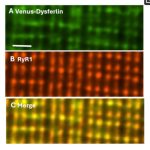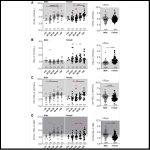2 New Dysferlin Publications: CALCIUM REGULATION | LIPIDS AND DYSFERLIN
In this latest Dysferlin Research Blog from the Jain Foundation, we’re highlighting two recent publications below that may be of interest to dysferlin research and clinician communities.
Looking for more dysferlin specific published research? We’ve added these to our web page listing many more Dysferlin Publications from the last 5 years.

Title: “Dysferlin and the Regulation of Ca²⁺ Release in Skeletal Muscle”
In this review article, Bloch et al discuss how dysferlin contributes to both membrane repair and calcium (Ca²⁺) regulation in muscle. They summarize findings from their own work and that of others on how the loss of dysferlin affects Ca²⁺ leakage and Ca²⁺ transients. The authors also talk about how Ca²⁺ leak and levels are normally controlled and how they go awry in disease. In Section 6, Questions Remaining, the authors cover several important observations and raise noteworthy questions.
Figure 2 Dysferlin and RyR1 colocalize at triad junctions. Flexor digitorum brevis muscles of A/J mice were transfected by electroporation to express Venus-dysferlin Cells, 14(21), 1724. https://doi.org/10.3390/cells14211724
 Title: “High-Density Lipoprotein-Associated Cholesterol Abnormalities in a Clinical Outcomes Study of Dysferlin-Deficient Limb-Girdle Muscular Dystrophy Type R2”
Title: “High-Density Lipoprotein-Associated Cholesterol Abnormalities in a Clinical Outcomes Study of Dysferlin-Deficient Limb-Girdle Muscular Dystrophy Type R2”
White et al investigated circulating lipids and markers of hepatic & muscle function values from blood samples collected in the Jain Foundation’s International Clinical Outcome Study (COS) for dysferlinopathy to study how the role of cholesterol abnormalities in the absence of dysferlin could play a causal role in the muscle degenerative process.
They report a high prevalence of abnormal circulating lipid values in this population and early transaminase elevation, but with only minor changes in alkaline phosphatase-suggesting that the dyslipidemic state is not the result of liver dysfunction, and that the elevated transaminases originate primarily from muscle.
The authors propose that the dysferlin deficiency may lead to a distinct form of dyslipidemia as a metabolic comorbidity driving skeletal muscle degeneration.
Figure 1: Baseline measures of plasma lipoprotein levels in male and female LGMDR2 patients stratified by age.
J Cachexia Sarcopenia Muscle 2025 Aug 15;16(4):e70042. doi: 10.1002/jcsm.70042 Copyright and License information















